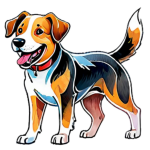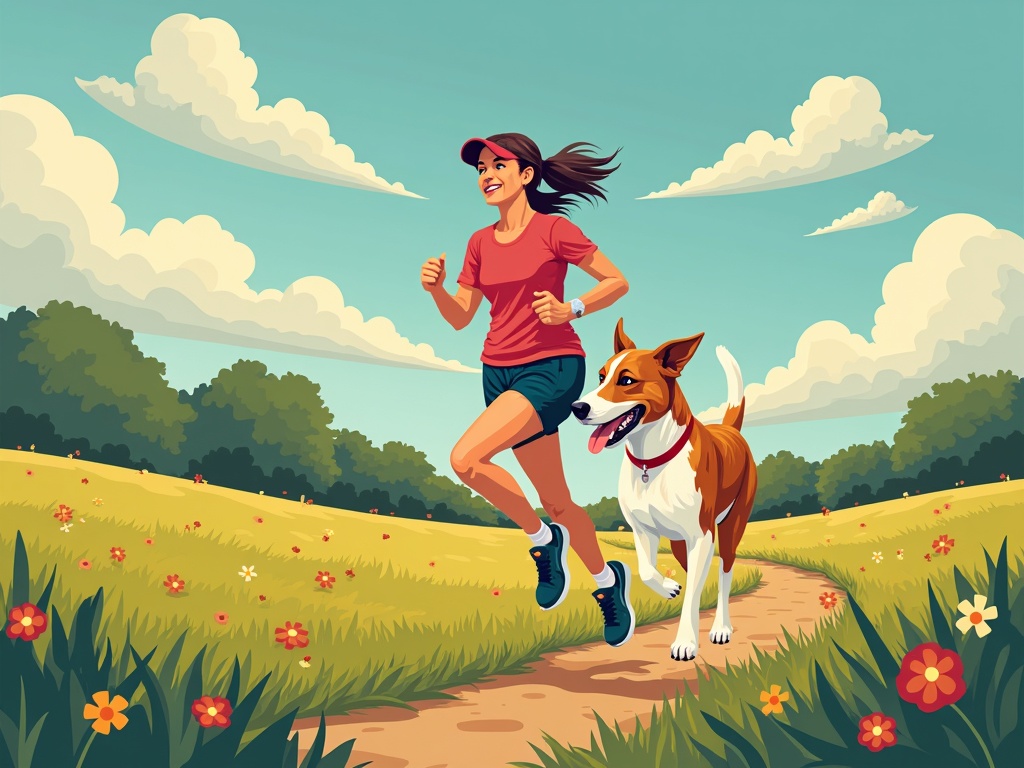What is Canicross? A Beginner's Guide to Running With Your Dog
Imagine sprinting through a forest trail, the crisp morning air filling your lungs, the only sound your synchronized breathing with your four-legged best friend. This isn’t just a dream; it’s Canicross – a sport that’s rapidly gaining popularity worldwide. But what exactly *isCanicross, and how can you and your canine companion get involved? Let's dive in!
The Basics: Defining Canicross
Canicross is, at its heart, off-road running *withyour dog. Originating as off-season training for sled dog racers, it has evolved into a sport enjoyed by anyone looking for a more engaging and challenging way to exercise with their dog. Unlike simply walking your dog on a leash, Canicross involves specific equipment and techniques designed to maximize comfort and efficiency for both human and animal. It’s more than just a walk in the park; it's a partnership, a thrilling adventure, and a fantastic workout all rolled into one!
The Gear: Essential Equipment for Canicross
Before you hit the trails, you’ll need the right equipment. This isn’t just about safety; it’s about ensuring both you and your dog have a comfortable and enjoyable experience. Here's a breakdown of the essentials:
**Canicross Belt:This is a specialized belt worn around your waist, designed to distribute the pulling force evenly and protect your back. Look for a comfortable, adjustable belt with padding and leg straps to prevent it from riding up.
**Bungee Leash (or Canicross Line):This leash connects you to your dog’s harness and incorporates a section of elastic or bungee cord. This crucial element absorbs the shock of your dog's pulls, preventing jarring impacts on both of you. Standard lengths usually range from 6 to 8 feet when stretched.
**Dog Harness:Absolutely *nota collar! A well-fitting dog harness is essential for Canicross. It should be designed specifically for pulling sports, distributing the force across your dog's chest and shoulders without restricting their movement or breathing. Y-shaped harnesses are a popular and ergonomic choice.
Choosing the Right Gear
**Fit is paramount:Ill-fitting gear can cause discomfort, chafing, and even injury. Get professionally fitted for both your belt and your dog's harness.
**Quality matters:Invest in durable, high-quality equipment. It will withstand the rigors of the trail and last longer.
**Consider the climate:If you live in a hot climate, opt for a breathable harness and ensure your dog has access to plenty of water.
Benefits of Canicross: More Than Just Exercise
Canicross isn't just a fun way to exercise; it offers a multitude of benefits for both you and your dog:
**Improved Physical Fitness:It’s a full-body workout for both humans and canines, improving cardiovascular health, strength, and endurance.
**Mental Stimulation:The change of scenery and the challenge of the run provide mental stimulation for your dog, reducing boredom and potentially destructive behaviors.
**Strengthened Bond:Canicross fosters a deeper connection between you and your dog through teamwork and shared experiences.
**Weight Management:A great way to combat obesity in both humans and dogs.
**Socialization (for dogs):Running in group settings can help dogs improve their social skills with other dogs, under proper supervision.
Getting Started: A Gradual Approach to Canicross
Ready to give Canicross a try? Here’s how to get started safely and effectively:
1. **Consult Your Doctor and Veterinarian:Before starting any new exercise program, it’s essential to get the green light from both your doctor and your veterinarian. This is especially important if you or your dog have any pre-existing health conditions.
2. **Start Slow:Don’t try to run a marathon on your first outing! Begin with short walks, gradually incorporating jogging intervals. Increase the distance and intensity as you and your dog build stamina.
3. **Teach Basic Commands:Before hitting the trails, make sure your dog knows basic commands like walk, easy, stop, left, and right. These commands are crucial for controlling your dog's pace and direction during the run and ensuring trail etiquette.
4. **Introduce the Gear:Let your dog get used to wearing the harness and being attached to the bungee leash *beforeyou start running. Practice walking with the gear in a familiar environment, rewarding your dog for calm and relaxed behavior.
5. **Find a Suitable Trail:Choose a relatively flat, well-maintained trail with good footing. Avoid trails with hazards like loose rocks, exposed roots, or excessive traffic.
6. **Hydration is Key:Always bring plenty of water for both you and your dog, especially on warm days. Offer water frequently during and after the run. A collapsible bowl is a handy accessory.
7. **Be Mindful of Your Dog's Signals:Pay close attention to your dog’s body language. If they’re panting excessively, lagging behind, or showing signs of discomfort, stop and rest. Don’t push them beyond their limits.
Training Tips: Building Stamina and Refining Technique
Once you and your dog are comfortable with the basics, you can start incorporating specific training techniques to improve your performance and enjoyment of Canicross:
**Interval Training:Alternate between high-intensity bursts of running and periods of active recovery (walking or jogging). This helps improve cardiovascular fitness and speed.
**Hill Work:Running uphill builds strength and endurance. Start with short, gradual inclines and gradually increase the length and steepness as you and your dog become stronger.
**Directional Training:Practice using directional commands (left, right, straight) to navigate the trail efficiently. This improves communication and teamwork.
**Off-Leash Training (optional):If you plan to participate in Canicross races, consider incorporating off-leash training into your routine. This helps your dog learn to stay focused and follow your commands even without the physical connection of the leash. *Alwaysensure this is in a safe and legal area.
Canicross Etiquette: Sharing the Trail Responsibly
Just like any outdoor activity, Canicross has its own set of etiquette guidelines to ensure everyone can enjoy the trails safely and respectfully:
**Yield to Other Trail Users:Be courteous and yield to hikers, bikers, and other trail users. Step aside to allow them to pass safely.
**Control Your Dog:Keep your dog under control at all times, and be prepared to stop or redirect them if necessary.
**Clean Up After Your Dog:Always clean up after your dog and dispose of waste properly. No one wants to step in dog poop! Carry dog waste bags with you.
**Respect Wildlife:Observe wildlife from a distance and avoid disturbing their habitat.
**Be Aware of Trail Conditions:Check trail conditions before you head out. Be prepared for mud, ice, or other hazards.
**Consider attending a local Canicross group**: Learn techniques, trail etiquette and more with experienced runners and dog handlers.
Canicross Competitions: Taking Your Skills to the Next Level
If you and your dog are enjoying Canicross and want to test your skills, consider entering a competition. Canicross races are typically held on off-road trails and vary in distance from 5k to 10k. They’re a fun and challenging way to push your limits and connect with other Canicross enthusiasts.
What to Expect at a Canicross Race
**Pre-Race Briefing:You’ll attend a pre-race briefing where organizers will outline the course, rules, and safety procedures.
**Staggered Start:Races typically use a staggered start to prevent congestion on the trail.
**Trail Markings:The course will be clearly marked with flags, ribbons, or cones.
**Water Stations:Water stations will be available for both humans and dogs along the course.
**Post-Race Celebration:After the race, there’s usually a post-race celebration with food, drinks, and awards.
Is Canicross Right for Your Dog? Considerations for Breed and Temperament
While Canicross can be enjoyed by dogs of all shapes and sizes, some breeds and temperaments are better suited to the sport than others. High-energy breeds like Huskies, German Shepherds, Border Collies, and Vizslas typically excel at Canicross due to their natural athleticism and desire to work. However, even smaller or less athletic breeds can enjoy Canicross as long as they’re healthy and have the right temperament.
Key considerations:
**Age:Puppies and senior dogs may not be suitable for Canicross due to their developing or declining physical capabilities.
**Health:Dogs with pre-existing health conditions, such as arthritis, hip dysplasia, or respiratory problems, should not participate in Canicross.
**Temperament:Dogs with a strong prey drive or a tendency to chase other animals may require extra training to ensure they can run safely and respectfully on the trail.
**Size/Build:Brachycephalic (short-nosed) breeds may have difficulty breathing during intense exercise and may not be well-suited to Canicross.
Canicross: A Rewarding Journey for You and Your Dog
Canicross is more than just a sport; it’s a journey of discovery, connection, and shared adventure with your canine companion. It's about pushing your limits, exploring new trails, and forging an even stronger bond with your best friend. So, gear up, get out there, and experience the joy of running free with your dog! Just remember to start slow, listen to your dog, and most importantly, have fun!


